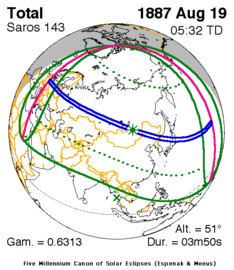Nature Total Magnitude 1.0518 Max. width of band 221 km (137 mi) Start date August 19, 1887 | Gamma 0.6312 Duration 230 sec (3 m 50 s) Greatest eclipse 5:32:05 | |
 | ||
A total solar eclipse occurred on August 19, 1887. A solar eclipse occurs when the Moon passes between Earth and the Sun, thereby totally or partly obscuring the image of the Sun for a viewer on Earth. A total solar eclipse occurs when the Moon's apparent diameter is larger than the Sun's, blocking all direct sunlight, turning day into darkness. Totality occurs in a narrow path across Earth's surface, with the partial solar eclipse visible over a surrounding region thousands of kilometres wide. It was visible across Europe, Asia, and Japan.
Contents
Observations
The Russian chemist Dmitri Mendeleev ascended in a balloon near Moscow to observe this eclipse.
Solar 143
It is a part of Saros cycle 143, repeating every 18 years, 11 days, containing 72 events. The series started with partial solar eclipse on March 7, 1617 and total event from June 24, 1797 through October 24, 1995. It has hybrid eclipses from November 3, 2013 through December 6, 2067, and annular eclipses from December 16, 2085 through September 16, 2536. The series ends at member 72 as a partial eclipse on April 23, 2873. The longest duration of totality was 3 minutes, 50 seconds on August 19, 1887.
